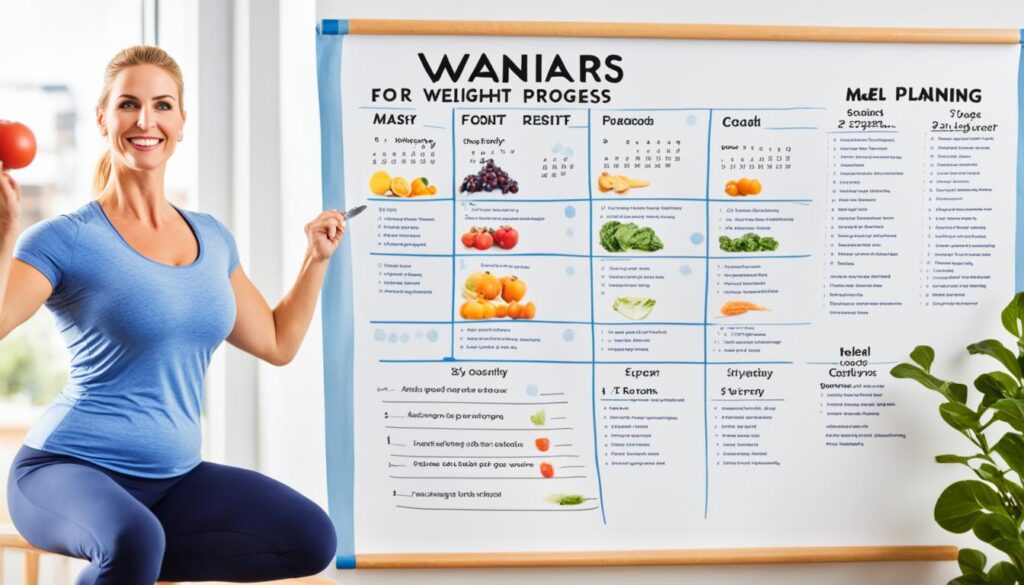Looking for ways to shed those extra pounds? You’re in the right place! This article will cover steps to help you slim down and stay healthy. You’ll learn to eat fewer calories, move more, and find a way to enjoy various foods while on your journey.
Key Takeaways:
- Assess your motivation and readiness to make permanent changes.
- Find your inner motivation and build a supportive network.
- Set realistic goals and focus on process goals for weight loss.
- Adopt a balanced, plant-based eating style to enjoy healthier foods.
- Engage in regular exercise to stay active and burn calories.
Strategies for Long-Term Weight Loss
When tackling weight loss, think beyond quick fixes. To truly change, adopt a new lifestyle. This lifestyle should include healthy habits. Such habits will keep you motivated over time. Here are strategies to reach your goal and stay there.
Finding Inner Motivation
To create lasting change, find what drives you from within. Figure out why you want to shed weight and be healthier. Maybe it’s for confidence or to inspire your loved ones. Knowing this will keep you going strong.
Creating a Support Network
A strong support system is crucial for weight loss. Surround yourself with cheerleaders. They should understand your goals and push you forward. Join a support group, either in person or online. This can provide needed advice and a sense of community.
Setting Realistic Goals
Real and reachable goals are vital for long-term success. Instead of just focusing on your weight, set goals that promote healthy living. For instance, pledge to work out more or eat more fruits and veggies. These steps keep you on track and motivated.
Enjoying Healthier Foods
Eating well is a must for keeping the weight off. Fill your plate with whole foods like veggies, fruits, lean meats, and grains. Try new dishes to keep your meals fresh and fun.
Staying Active
Being active is a big part of staying fit. Pick activities you like and do them daily. Shoot for 150 minutes of moderate exercise each week. And do strength training to add muscle and amp up your metabolism.
Changing Your Perspective
Changing how you see weight loss is key for lasting results. Don’t see it as a short-term goal. Treat it as a shift to a healthier life. Focus on habits like eating mindfully and managing stress. These should become natural over time.
These strategies can jumpstart your weight loss journey and make it last. Remember, it’s about getting healthier overall, not just losing weight.
Assessing Readiness for Weight Loss
Before you start a weight loss journey, check if you’re ready. Successful weight loss needs a strong base, mentally and emotionally. Look at some important points to gauge your readiness:
- Motivation: Why do you want to lose weight? Do health issues, wanting to feel better, or to boost self-confidence drive you? Knowing your why can keep you on track.
- Coping with Stress: Losing weight can stress you out. So, see how well you handle stress. It’s key to find healthy ways to deal like mindfulness, working out, or talking to loved ones.
- Changing Habits: To lose weight, you’ll need to alter your daily routines and pick up healthier ones. Think about whether you’re ready to change and add new practices for a better life.
- Support: Think about who’s there for you. It could be a friend, family, or a support group. Having understanding people on your journey matters a lot.
Evaluating your readiness for weight loss and looking at these aspects can prepare you better. Don’t forget, long-term weight loss is more than just your body changing. It’s about remaking your habits and how you think.

Finding Inner Motivation
The journey to lose weight starts within yourself. You’re the one who has to make it happen. This is where inner motivation comes in handy. It keeps you on track and driven. It’s your push to choose healthier ways and reach your goals.
To find your inner motivation, think hard about why you want to lose weight. Is it for your health, self-esteem, or happiness? Cling to this reason. It will be your north star, reminding you why you began.
It can be tough to stay focused on losing weight. But, with the right mindset and support, it’s possible. Having a group of people who encourage you is key. This can be friends, family, or a weight-loss group. They offer advice and a listening ear when things get hard.
Your support system is crucial. They cheer you on, help you celebrate wins, and support you through tough times. Their confidence in you is a game-changer.
Set smaller and clear goals to stay focused and motivated. Divide your weight loss plan into smaller parts, making it easier to stay encouraged and feel accomplished.
Discovering your inner drive and having a supportive group are critical for losing weight long-term. Keep digging deep, stay focused, and remember why you started.
Quotes:
“Your inner motivation is your superpower. It helps you beat challenges and reach your weight loss goals.” – Jane Smith
“Having supportive people around you can significantly help in keeping your eye on the prize.” – Dr. Emily Johnson
Tips for Finding Inner Motivation:
- Think about what drives you to lose weight.
- Write your goals down and always keep them in sight.
- Lean on a support group or your loved ones for help.
- Celebrate every success to stay motivated.
- Make time for self-care and keep a positive mind.
Benefits of Inner Motivation
| Benefits | Description |
|---|---|
| Increased Determination | Inner motivation boosts your determination to achieve your weight loss goals. This is crucial, especially when things get hard. |
| Sustained Focus | It’s easier to stay focused on your journey with strong inner motivation. This helps you steer clear of distractions. |
| Long-Term Commitment | Inner motivation pushes you to make lifestyle changes for the long run. This is key for lasting weight loss success. |
| Positive Mindset | It helps develop a positive attitude. This lets you move past setbacks and barriers as you go. |
Setting Realistic Goals
Setting realistic goals for weight loss is key for long-term success. It makes sure you stay motivated on your journey. Aim for both short-term and long-term goals to keep you focused.
Try to lose 1-2 pounds a week. This approach is healthier and easier. Avoid quick-fix diets because they often don’t last.
Process goals are small steps that help you lose weight. They could be exercising more, drinking water, or eating smaller portions. These actions build the foundation of your weight loss journey.
Outcome goals are your big weight loss dreams, like fitting into a certain size dress or improving your health. They are what you ultimately want to achieve.
Here’s a quote to inspire you from Tony Robbins:
“Setting goals is the first step in turning the invisible into visible.”
Realistic goals are like a map that leads you to success. By setting clear process and outcome goals, you lay out a path for success.
Let’s break down the differences between process and outcome goals:
| Process Goals | Outcome Goals |
|---|---|
| Focus on building healthy habits | Focus on desired results |
| Specific actions and behaviors | End results |
| Support weight loss journey | Measure progress and success |
Healthy habits are at the core of long-lasting weight loss. By mixing process and outcome goals, you set up a solid plan for success. Never stop moving forward and stay true to your path!

Enjoying Healthier Foods
Healthy eating is key for losing weight. Choose foods that are low in calories but full of nutrition. Eat lots of plant-based foods like fruits, veggies, and whole grains. They give your body what it needs without too many calories.
A varied diet keeps you full and happy. Mix up your meals with different fruits, veggies, grains, and proteins. Trying new recipes and food styles keeps things interesting. It also helps you avoid getting bored.
The Benefits of Plant-Based Foods
Plant foods are great for losing weight and staying healthy. They usually have fewer calories and bad fats than meat. For instance, green veggies are full of good stuff. They help you feel full and keep your gut working well.
Plant foods are rich in nutrients, too. They bring lots of vitamins, minerals, and antioxidants to your body. Eating plenty of fruits and veggies gives you what you need for good health.
Creating Variety in Your Diet
Sticking to the same foods can happen, but it’s important to mix it up. Add different types of food to your meals. Try new vegetables, grains, and protein sources. This way, you enjoy different tastes and get a wide range of nutrients.
Here are tips for adding variety:
- Try new food from different cultures.
- Eat a new fruit or veggie every week.
- Discover whole grains like quinoa and brown rice.
- Enjoy plant proteins such as beans and tofu.
- Spice up your meals with herbs and seasonings.
| Food Group | Examples |
|---|---|
| Fruits | Apples, bananas, oranges, berries |
| Vegetables | Spinach, broccoli, carrots, peppers |
| Whole Grains | Quinoa, brown rice, oats, whole wheat bread |
| Legumes | Chickpeas, lentils, black beans, edamame |
Eating well should be enjoyable, not boring. Focus on plant foods and mix up what you eat. This will make your weight loss journey both healthy and fun.
Staying Active
Regular physical activity is key for weight loss. It burns calories and boosts health. Adding exercise to your daily life helps you lose weight and keep it off.
Try to do 30 minutes of aerobic exercise daily. This could be walking fast, running, biking, or swimming. Aerobic exercises make your heart rate go up and help burn calories.
Every bit of exercise helps, even if it’s not for a full 30 minutes at a time. Use stairs, walk or bike to work, or do a quick workout at lunch. Moving more during the day helps burn calories and aids weight loss.

Physical activity does more than burn calories. It makes muscles and bones stronger, boosts heart health, and lowers disease risks. Plus, it makes you feel happier, less stressed, and sleep better.
Exercise Benefits
Exercise aids in losing weight and offers extra benefits:
- Increased energy levels and improved stamina
- Boosted metabolism, even at rest
- Enhanced mental clarity and focus
- Reduced risk of depression and anxiety
- Improved immune function and overall health
- Increased self-confidence and body image
Make exercise a habit to boost your health over time. Choose fun activities that keep you interested and active.
| Types of Physical Activity | Calories Burned per Hour* |
|---|---|
| Brisk Walking | 240-350 calories |
| Jogging/Running | 400-800 calories |
| Cycling | 400-650 calories |
| Swimming | 400-700 calories |
| Dancing | 300-600 calories |
*Caloric use changes with weight, intensity, and time.
Adding regular exercise to your life supports weight loss and boosts well-being. Aim for 30 minutes of aerobic activity every day. Do what you enjoy, whether it’s walking, running, cycling, swimming, or dancing. Staying active helps keep off weight and improves your fitness.
Changing Perspective on Weight Loss
Weight loss isn’t just about changing what you eat or how you exercise briefly. It involves long-term lifestyle changes. By seeing things differently and starting fresh, you can manage your weight over time.
Start by looking at what you eat and do each day. Figure out areas for improvement. You might need to eat smaller portions, choose healthier foods, and avoid eating when you’re not hungry.
Remember, aim for a diet that you can keep up with and that helps you lose weight.
Changing habits is key to how you view weight loss. It’s tough but doable with effort. Start with small steps, like eating fruit instead of sweets or taking walk breaks.
Stay ready for bumps in the road while you work on losing weight. It’s common to face challenges, but don’t let them stop you. Learn from mistakes and use them to keep going strong.
Seeing every new day as a chance to be healthier can motivate you. Forget about past disappointments. Focus on now.
Altering your diet, habits, and view on weight loss leads to ongoing success. Weight loss is a process. It’s the small, daily choices that matter most for real and lasting change.
Example Table: Healthy Habits Comparison
| Unhealthy Habits | Healthy Habits |
|---|---|
| Eating fast food regularly | Preparing meals at home using fresh ingredients |
| Sedentary lifestyle | Incorporating regular physical activity into daily routine |
| Uncontrolled portion sizes | Practicing mindful eating and portion control |
| Emotional eating | Finding healthier ways to cope with emotions |
| Inconsistent sleep patterns | Prioritizing quality sleep for overall health and well-being |
Identify Triggers and Develop Healthy Habits
Figuring out why you eat when you’re not hungry is key to losing weight. It happens when you use food to deal with stress or sadness. Instead of eating your feelings, look into what triggers this habit. Then, find better ways to cope. This will stop food from being your go-to comfort.

Finding Healthy Alternatives
Taking a moment before digging into food can really help. Try mindful eating. It’s about really tasting your food and noticing when you’re full. You’ll enjoy your meals more and not need as much to feel satisfied.
“Mindful eating is about savoring each bite, paying attention to your body’s signals, and nourishing yourself in a holistic way. It allows you to connect with your emotions and find healthier ways to address them.”
– Dr. Emily Roberts, PhD
Watching your serving sizes is also smart. Use smaller plates and measure your food. Eating slowly and enjoying each bite will aid in creating better eating habits.
Overcoming Setbacks and Staying Motivated
Don’t worry too much if you slip up. Overcoming emotional eating isn’t easy. Just think about what made you do it, so you can avoid it next time. Having people to talk to or doing activities that calm you down can be very helpful.
Keep pushing by setting small goals. Celebrate your progress with treats that are not food. A little reward, like reading a new book or time with friends, can go a long way.
In short, knowing your emotional eating triggers and changing your habits is vital for losing weight. Use mindful eating and control your portions. Also, find new ways to deal with stress. This will help you stay balanced and healthy.
Avoiding Fad Diets and Empty Calories
Many people think fad diets and low-nutrient foods are the way to go for quick weight loss. But these quick fixes are not good for your health in the long term. It’s better to choose nutrient-rich foods and a lifestyle of healthy eating.
Fad diets sound great with their fast promises but they often lack essential nutrients. They also can cause health problems by cutting out important foods. And, after you stop the diet, you might gain the weight back quickly.
To truly lose weight and keep it off, eat foods high in nutrients like vitamins, minerals, and fiber. Focus on things like fruits, vegetables, lean meats, and whole grains. These also help you stay full and not always hungry.
Stay away from bad foods full of sugars, unhealthy fats, and processed grains. Things like fast food, snacks, and sugary drinks are not good for you. Eating them will just make it harder to lose weight and stay healthy.
Healthy eating is all about balance that fits your lifestyle. It’s not about strict diets or taking away foods you love. Eat a variety of foods, but watch how much and listen to your body’s signals. Eating in moderation and paying attention to when you’re full are key.
Choosing nutrient-rich foods and a healthy eating style will help you reach a good weight. Plus, your body will get all the good stuff it needs to stay healthy and strong.
| Unhealthy Foods to Avoid | Nutrient-Dense Choices |
|---|---|
| Sugary drinks | Water, herbal tea |
| Fast food | Homemade meals with fresh ingredients |
| Processed snacks | Fresh fruits and vegetables |
| Refined grains | Whole grains |
| Fried foods | Grilled or baked options |
Conclusion
Losing weight and staying healthy needs a commitment to long-lasting methods. In this article, we discussed ways to set real goals, like healthier foods, and getting more active. Changing how you think about losing weight is also key.
Remember, losing weight takes time and not a quick solution. It’s about dedication and keeping up with healthy habits. By making food and exercise changes for good, you can achieve long-term success. Don’t forget the importance of staying inspired, supported by loved ones, and making health a top priority.
Choosing a way to lose weight that’s sustainable can keep you on track for the long haul. It involves looking at your overall health and well-being, not just short-term fixes. Commit to lasting changes, be steady in your efforts, and adopt a healthier life. This path can bring you joy and fulfillment.
FAQ
What are the strategies for long-term weight loss?
To lose weight long term, change how you eat and move for good. Being motivated, finding reasons inside you to succeed, and having support are key. Also, set goals you can really reach, like eating better. Staying active and seeing weight loss in a new light help a lot.
How do I assess my readiness for weight loss?
It’s vital to check if you’re ready to change for good before starting. Think about your willpower, handling stress, and being open to new habits. Also, consider if you have enough support. Being set in your mind and heart is essential for the long haul.
How can I find my inner motivation?
Losing weight starts with you deciding to. Find what really makes you want to change and focus on that. Have people around you who are there to cheer you on. This helps you stick with it.
How should I set realistic weight-loss goals?
Real goals are crucial for making it. Try to lose 1 to 2 pounds a week. Focus on steps and results. Doing things like regular workouts helps you build the right habits.
What should I do to enjoy healthier foods?
Change how you eat to lose weight by picking foods that are good for you. Go for fewer calories and healthier choices. Choose lots of plant foods like fruit and veggies. Mixing up what you eat keeps it interesting and good for you.
How can I stay active for weight loss?
Working out is key to losing weight by burning calories. Try for at least 30 minutes of exercise almost every day. Also, any extra moving you do all helps count too. Staying active helps keep the weight off for the long term.
How do I change my perspective on weight loss?
Weight loss is more than just a diet or hitting the gym for a bit. It’s about changing how you live forever. Look at what you eat and do each day. Try to change some bad habits. Be ready for tough times but keep going. Starting anew and sticking to a healthier way is the real path to last-longing results.
How can I identify triggers for emotional eating?
Knowing what makes you eat when you’re not really hungry is crucial. It’s all about having good eating habits, being mindful of what you eat, and not eating too much. Find ways to handle when things get hard and stay motivated through it all.
How do I avoid fad diets and empty calories?
Forget quick fix diets and foods that don’t give you much. Focus on eating well for the long haul. Stay away from too much sugar and processed foods. Go for stuff that’s packed with good things like fruits, veggies, and lean proteins. Balance what you eat so it’s something you can keep doing.
What is the conclusion of the weight loss strategies?
To lose weight and keep it off, commit to long-lasting changes. Use the steps here: set real goals, enjoy healthy foods, stay active, and change your view on weight loss. Keep motivated, get support, and make changes that stick for success.




















